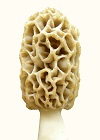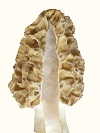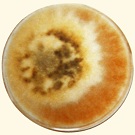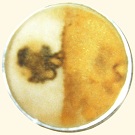 |
|
Research Photo Pages


|
Anomalies are rare and informative in science. The morel anomaly defies usual evolution and physiology in an extreme way thereby providing much information. Species usually have a fixed shape (morphology) which cannot vary much. If animals have a birth defect, it can be traced to one step in embryonic development. The morel anomaly is not off by one step; all of its morphology is off and some of its physiology. The moral anomaly occurs when the mycelium grows on the surface of a liquid or gel with optimum nutrition. A detailed nutritional study was required to optimize nutrition. When the anomaly occurs, the mycelium starts to change its morphology and physiology without forming anything resembling a mushroom. It forms visible pigment and a variety of cell structures at the microscopic level, while it forms a flat sheet on the surface. For mushroom cells to grow flat on a surface and produce pigment is an extreme anomaly. It isn't just one thing wrong with the morphology; it is everything wrong with the morphology. The physiology produces pigment when there is no mushroom for the pigment. The loops and curls in these anomalies are rudimentary formations of ridges and pits on the surface of the tissue. The tissue in the anomalies partially differentiates into the morphology of the mushroom. One important thing that the anomaly says is that the morphological structure of the morel has not been stabilized the way it is for other species. Other species cannot revert to some other shape, because there is no pattern other than their usual shape. But the morel has a pattern to follow when growing on a flat surface. This means the morel was growing on a flat surface so recently that it still carries the pattern for flat surface growth in its DNA; and the DNA transcription can revert to that pattern. It is surprising that DNA can carry a pattern which can no longer be used. The flat-growth-pattern is in fact integrated into the normal pattern, which scrambles the characteristics of the anomaly. The pigments in the anomaly are characteristic of the normal morel strain. In other words, if the strain has a red pigment, it shows up in the anomaly, and if it has a black pigment, it shows up in the anomaly. Other evidence shows that the morel evolved from a yeast. This includes the physiological production of acid from sugars, which would be very detrimental to normal mycelium. And it includes the use of ascospores, which is very detrimental to any mushroom and points to yeast origins for most ascosporogenous, higher fungi.
|



